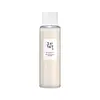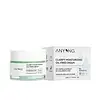What's inside
What's inside
 Key Ingredients
Key Ingredients

 Benefits
Benefits

 Concerns
Concerns

 Ingredients Side-by-side
Ingredients Side-by-side

Water
Skin ConditioningMethylpropanediol
SolventPropanediol
Solvent1,2-Hexanediol
Skin ConditioningGlycerin
HumectantGlycereth-26
HumectantPolymethyl Methacrylate
Oryza Sativa Extract
AbsorbentCoptis Japonica Root Extract
Skin ConditioningUlmus Davidiana Root Extract
Skin ConditioningAmaranthus Caudatus Seed Extract
Skin ConditioningFicus Carica Fruit Extract
HumectantCentella Asiatica Extract
CleansingTheobroma Cacao Seed Extract
AntioxidantHydrogenated Lecithin
EmulsifyingSodium Hyaluronate
HumectantPanthenol
Skin ConditioningHydroxyethyl Urea
HumectantAluminum Chlorohydrate
AstringentButylene Glycol
HumectantMicrocrystalline Cellulose
AbsorbentSodium Citrate
BufferingKaolin
AbrasiveEthylhexylglycerin
Skin ConditioningDipotassium Glycyrrhizate
HumectantCitric Acid
BufferingDextrin
AbsorbentCeramide NP
Skin ConditioningTocopherol
AntioxidantRice Amino Acids
Skin ConditioningWater, Methylpropanediol, Propanediol, 1,2-Hexanediol, Glycerin, Glycereth-26, Polymethyl Methacrylate, Oryza Sativa Extract, Coptis Japonica Root Extract, Ulmus Davidiana Root Extract, Amaranthus Caudatus Seed Extract, Ficus Carica Fruit Extract, Centella Asiatica Extract, Theobroma Cacao Seed Extract, Hydrogenated Lecithin, Sodium Hyaluronate, Panthenol, Hydroxyethyl Urea, Aluminum Chlorohydrate, Butylene Glycol, Microcrystalline Cellulose, Sodium Citrate, Kaolin, Ethylhexylglycerin, Dipotassium Glycyrrhizate, Citric Acid, Dextrin, Ceramide NP, Tocopherol, Rice Amino Acids
Water
Skin ConditioningCentella Asiatica Leaf Extract
Skin ConditioningBacillus
Skin ConditioningNiacinamide
SmoothingSodium Hyaluronate
HumectantCapryloyl Salicylic Acid
ExfoliatingButylene Glycol
HumectantPropylene Glycol
HumectantAloe Barbadensis Leaf Juice
Skin ConditioningEctoin
Skin ConditioningGlycerin
HumectantSalix Alba Bark Extract
AstringentGinkgo Biloba Leaf Extract
Skin ConditioningInulin
Skin ConditioningFructose
HumectantAllantoin
Skin ConditioningMadecassic Acid
Skin ConditioningAsiaticoside
AntioxidantAsiatic Acid
Skin ConditioningPanthenol
Skin ConditioningSodium PCA
HumectantSorbitol
HumectantSpirulina Platensis Extract
Skin ProtectingPotassium Sorbate
PreservativeAcrylates/C10-30 Alkyl Acrylate Crosspolymer
Emulsion Stabilising1,2-Hexanediol
Skin ConditioningCaprylyl Glycol
EmollientPentylene Glycol
Skin ConditioningEthylhexylglycerin
Skin ConditioningWater, Centella Asiatica Leaf Extract, Bacillus, Niacinamide, Sodium Hyaluronate, Capryloyl Salicylic Acid, Butylene Glycol, Propylene Glycol, Aloe Barbadensis Leaf Juice, Ectoin, Glycerin, Salix Alba Bark Extract, Ginkgo Biloba Leaf Extract, Inulin, Fructose, Allantoin, Madecassic Acid, Asiaticoside, Asiatic Acid, Panthenol, Sodium PCA, Sorbitol, Spirulina Platensis Extract, Potassium Sorbate, Acrylates/C10-30 Alkyl Acrylate Crosspolymer, 1,2-Hexanediol, Caprylyl Glycol, Pentylene Glycol, Ethylhexylglycerin
 Reviews
Reviews

Ingredients Explained
These ingredients are found in both products.
Ingredients higher up in an ingredient list are typically present in a larger amount.
1,2-Hexanediol is a synthetic liquid and another multi-functional powerhouse.
It is a:
- Humectant, drawing moisture into the skin
- Emollient, helping to soften skin
- Solvent, dispersing and stabilizing formulas
- Preservative booster, enhancing the antimicrobial activity of other preservatives
Butylene Glycol (or BG) is used within cosmetic products for a few different reasons:
Overall, Butylene Glycol is a safe and well-rounded ingredient that works well with other ingredients.
Though this ingredient works well with most skin types, some people with sensitive skin may experience a reaction such as allergic rashes, closed comedones, or itchiness.
Learn more about Butylene GlycolEthylhexylglycerin (we can't pronounce this either) is commonly used as a preservative and skin softener. It is derived from glyceryl.
You might see Ethylhexylglycerin often paired with other preservatives such as phenoxyethanol. Ethylhexylglycerin has been found to increase the effectiveness of these other preservatives.
Glycerin is already naturally found in your skin. It helps moisturize and protect your skin.
A study from 2016 found glycerin to be more effective as a humectant than AHAs and hyaluronic acid.
As a humectant, it helps the skin stay hydrated by pulling moisture to your skin. The low molecular weight of glycerin allows it to pull moisture into the deeper layers of your skin.
Hydrated skin improves your skin barrier; Your skin barrier helps protect against irritants and bacteria.
Glycerin has also been found to have antimicrobial and antiviral properties. Due to these properties, glycerin is often used in wound and burn treatments.
In cosmetics, glycerin is usually derived from plants such as soybean or palm. However, it can also be sourced from animals, such as tallow or animal fat.
This ingredient is organic, colorless, odorless, and non-toxic.
Glycerin is the name for this ingredient in American English. British English uses Glycerol/Glycerine.
Learn more about GlycerinPanthenol is a common ingredient that helps hydrate and soothe the skin. It is found naturally in our skin and hair.
There are two forms of panthenol: D and L.
D-panthenol is also known as dexpanthenol. Most cosmetics use dexpanthenol or a mixture of D and L-panthenol.
Panthenol is famous due to its ability to go deeper into the skin's layers. Using this ingredient has numerous pros (and no cons):
Like hyaluronic acid, panthenol is a humectant. Humectants are able to bind and hold large amounts of water to keep skin hydrated.
This ingredient works well for wound healing. It works by increasing tissue in the wound and helps close open wounds.
Once oxidized, panthenol converts to pantothenic acid. Panthothenic acid is found in all living cells.
This ingredient is also referred to as pro-vitamin B5.
Learn more about PanthenolSodium Hyaluronate is hyaluronic acid's salt form. It is commonly derived from the sodium salt of hyaluronic acid.
Like hyaluronic acid, it is great at holding water and acts as a humectant. This makes it a great skin hydrating ingredient.
Sodium Hyaluronate is naturally occurring in our bodies and is mostly found in eye fluid and joints.
These are some other common types of Hyaluronic Acid:
Learn more about Sodium HyaluronateWater. It's the most common cosmetic ingredient of all. You'll usually see it at the top of ingredient lists, meaning that it makes up the largest part of the product.
So why is it so popular? Water most often acts as a solvent - this means that it helps dissolve other ingredients into the formulation.
You'll also recognize water as that liquid we all need to stay alive. If you see this, drink a glass of water. Stay hydrated!
Learn more about Water